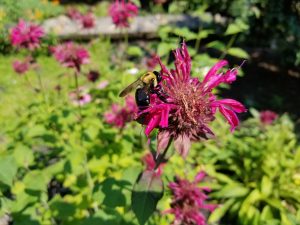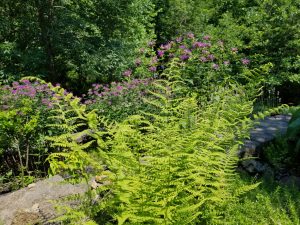Some summers back I bought a couple of bedraggled hemerocallis from Home Depot, hoping they might fill a couple of awkward spaces in my garden. A deep discount added motivation. They were quite a lovely color, too, shades of purple and yellow. I seem to have lost the tag with the name, but I suspect they are a common hybrid called “Purple d’Oro.”
I was hopeful for the success of the plant that landed in the sunnier location. Turns out that all that warmth and light was also pleasing to the nearby monarda, which has naturalized aggressively around it. The other I installed in a shadier spot and it is doing the botanical equivalent of man-spreading on a subway seat.
Daylilies
I’m not actually a daylily person. Around here they are too often deer salad, and that’s just a waste of garden space. What I like are flowers that nurture bees, butterflies and hummingbirds. More than that, as their name suggests, daylilies are something of a “here-today-gone-tomorrow” bloom, unsuited to duty in a vase.
I wondered, however, about the buds not yet opened. I did a quick Google search and found an article by Mary Walton Upchurch. She clearly has many more daylilies than I do, and pinches off the flowers to float them in shallow bowls of water. Clever! But a little finicky for me.
What would happen, though, if I put whole stems of daylilies in water? Beyond the certainty that that day’s blossoms would wilt by nightfall, I mean. Would the buds bloom, too? All of them or just the larger ones? I suppose I could simply go online and find answers to my questions, but discovery learning is more fun. I am perfectly willing, anyway, to sacrifice a few stems in the name of research and discovery.
The buds bloomed, providing a sequence of blossoms over quite a few days alongside the faded flowers that had been full and flashy the day before.
In the garden, new stems bud, new flowers blossom and fade. I can see why hemerocallis enjoys the adulation of so many. I’ve taken to checking on them in the evenings when I venture out to prune the monarda whose colorful, tousled petals don’t stay bright all that long. The echinacea are showy this year, despite obvious visits from the deer. Eupatorium, the wonderfully named Joe-Pye weed, have suffered more cervine attention, but I hope to see a few big roseate bundles of flowers soon. The butterflies do love them.
One Season at a Time
One day at a time, the gardens come into their seasonal displays.
Columbine give way as hay-scented ferns wiggle their way through a mat of moss phlox. Fiery orange milkweed advertise dinner to monarch butterflies. Pink-and-white bells on the bleeding heart tolled months ago and the leaves are now limp and brown. The variegated foliage of hellebore clump here and there, but the blooms shading from ivory through pinks to black-purple are gone, along with their companions, the bulbs: snowdrops, crocus, aconite, and daffodils. Junipers and pines, oaks, sycamores, gums and beeches, hollies and swamp magnolias surround it all in greens of every shade from almost-gold to nearly-blue.
One day at a time all those perennials age and retreat and rest until it is their turn again. One day they will all be back. I hope.




